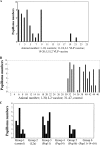Papillomavirus prophylactic vaccines: established successes, new approaches
- PMID: 19906917
- PMCID: PMC2812340
- DOI: 10.1128/JVI.01927-09
Papillomavirus prophylactic vaccines: established successes, new approaches
Abstract
Vaccines against the human papillomaviruses (HPVs) most frequently associated with cancer of the cervix are now available. These prophylactic vaccines, based on virus-like particles (VLPs), are extremely effective, providing protection from infection in almost 100% of cases. However, the vaccines present some limitations: they are effective primarily against the HPV type present in the vaccine, are expensive to produce, and need a cold chain. Vaccines based on the minor capsid protein L2 have been very successful in animal models and have been shown to provide a good level of protection against different papillomavirus types. The potential of L2-based vaccines to protect against many types of HPVs is discussed.
Figures



References
-
- Alphs, H. H., R. Gambhira, B. Karanam, J. N. Roberts, S. Jagu, J. T. Schiller, W. Zeng, D. C. Jackson, and R. B. S. Roden. 2008. Protection against heterologous human papillomavirus challenge by a synthetic lipopeptide vaccine containing a broadly cross-neutralizing epitope of L2. Proc. Natl. Acad. Sci. U.S.A. 105:5850-5855. - PMC - PubMed
-
- Antonsson, A., E. Payne, K. Hengst, and N. A. McMillan. 2006. The human papillomavirus type 16 E7 protein binds human interferon regulatory factor-9 via a novel PEST domain required for transformation. J. Interferon Cytokine Res. 26:455-461. - PubMed
-
- Ashrafi, G. H., D. R. Brown, K. H. Fife, and M. S. Campo. 2006. Down-regulation of MHC class I is a property common to papillomavirus E5 proteins Virus Res. 120:208-211. - PubMed
-
- Ashrafi, G. H., H. Mohammad, B. Marchetti, and M. S. Campo. 2006. E5 protein of human papillomavirus 16 downregulates HLA class I and interacts with the heavy chain via its first hydrophobic domain. Int. J. Cancer 119:2105-2112. - PubMed
Publication types
MeSH terms
Substances
Grants and funding
LinkOut - more resources
Full Text Sources

